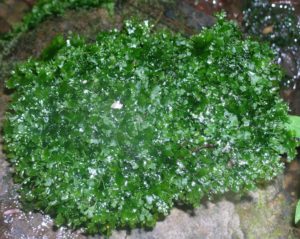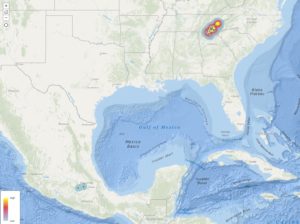
Sexual reproduction plays an essential role in species’ survival and maintenance and hence is, not surprisingly widespread across the Tree of Life. However, clonality and other forms of asexual reproduction do also exist, especially in plants. The hornwort Nothoceros aenigmaticus is a good example of a plant reproducing asexually and clonally as its male plants seem to produce non-functional sperm cells. This hornwort is distributed in the Southern Appalachians (SA) (United States), Mexico and in “alpine” regions of tropical South America. Unlike elsewhere in its range, male and female plants in the US are geographically separated by ca. 30 km across rivers and mountains, as they grow on rocks in different watersheds of the Tennessee and Alabama Rivers (SA). Whether male and female populations were geographically isolated to the extent that migration, and sporadic sexual reproduction was completely absent, and hence whether these populations relied always exclusively on asexual propagation was unknown. Resolving this uncertainty is critical to assess the vulnerability of these populations to environmental change.

To confirm the total reproductive isolation, reconstruct its origin, and assess the mode of reproduction of N. aenigmaticus in SA, we analyzed genetic data of more than 250 individuals of the species. Nothoceros aenigmaticus likely immigrated to the US from sexual Mexican ancestors about 600–800,000 years ago. The genomic data confirmed the absolute reproductive isolation between sexes and the absolute genetic isolation among SA populations. Populations from contiguous watersheds share clones, but individuals lack mixed genetic traits, consistent with the lack of sexual reproduction, as is their overall reduced genetic diversity.The SA drainage system is thought to have been remodeled by geological processes during the Pleistocene glaciations, which could have mixed genotypes from contiguous watersheds. This low overall extant genetic diversity and the extreme sex segregation point out the high vulnerability of N. aenigmaticus to extinction in the SA under major alteration of the habitats.
Special thanks to Paul Davidson for sharing photos of the species.
Alonso-Garcia M, Villarreal JC, McFarland K and Goffinet B (2020). Population Genomics and Phylogeography of a Clonal Bryophyte with Spatially Separated Sexes and Extreme Sex Ratios. Front. Plant Sci. 11: 495. doi: 10.3389/fpls.2020.00495.